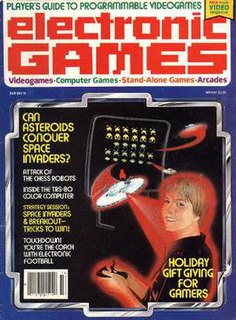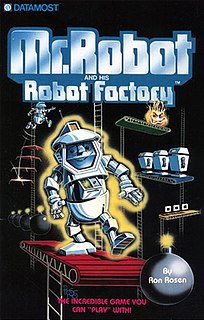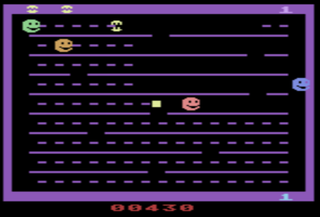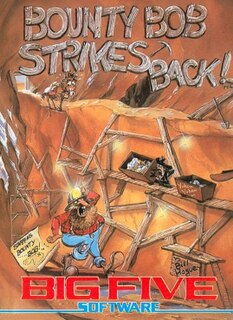
The Atari 2600, branded as the Atari Video Computer System until November 1982, is a home video game console developed and produced by Atari, Inc. Released in September 1977, it popularized the use of microprocessor-based hardware and of games stored on swappable ROM cartridges, a format first used with the Fairchild Channel F in 1976. The VCS was bundled with two joystick controllers, a conjoined pair of paddle controllers, and a game cartridge—initially Combat and later Pac-Man.

Jumpman is a platform game written by Randy Glover and published by Epyx in 1983. It was first developed for the Atari 8-bit family, and versions were also released for the Commodore 64, Apple II, and IBM PC.

Kaboom! is an action video game published in 1981 by Activision for the Atari VCS. It was programmed by Larry Kaplan, and David Crane coded the overlaid sprites. The game was well received and sold over one million cartridges by 1983.

Star Raiders is a first-person space combat simulator for the Atari 8-bit family of computers. It was written by Doug Neubauer, an Atari employee, and released as a cartridge by Atari in 1979. The game is considered the platform's killer app. It was later ported to the Atari 2600, Atari 5200, and Atari ST.
GameLine was a dialup game distribution service for the Atari 2600, developed and operated by Control Video Corporation (CVC). Subscribers could install the proprietary modem and storage cartridge in their home game console, accessing the GameLine service to download games over a telephone line. GameLine had an exclusive selection of games, and its pioneering business model eventually gave rise to America Online. Despite being ahead of its time, it wasn't very popular, possibly due to its price of $60 for the hardware, $15 for the membership fee, and $1 per game, which you could only keep for a week.

Miner 2049er is a platform video game created by Bill Hogue that was released in 1982 by Big Five Software. It was developed for the Atari 8-bit family and widely ported to other systems. The title "Miner 2049er" evokes a 21st-century take on the California Gold Rush of around 1849, in which the gold miners and prospectors were nicknamed "49ers".

The TV Boy and its successors TV Boy II and Super TV Boy are 1990s handheld TV games sold by many different companies, including Systema, Akor, and NICS, based upon an unlicensed clone of Atari 2600 hardware. They were widely available across Europe. In the UK they were most visibly available through Argos. They were released around 1992, and an improved version of the TV Boy 2, the Super TV Boy, was also made by Akor in 1995.
1982 was the peak year for the golden age of arcade video games as well as the second generation of video game consoles. Many games were released that would spawn franchises, or at least sequels, including Dig Dug, Pole Position, Mr. Do!, Pitfall!, Zaxxon and Q*bert. Additional game consoles add to a crowded market, notably the ColecoVision and Atari 5200. The new Commodore 64 goes on to eventually dominate the 8-bit home computer market in Europe. Troubles at Atari late in the year triggered the video game crash of 1983.

H.E.R.O. is a video game written by John Van Ryzin and published by Activision for the Atari 2600 in March 1984. It was ported to the Apple II, Atari 5200, Atari 8-bit family, ColecoVision, Commodore 64, MSX, and ZX Spectrum. The player uses a helicopter backpack and other tools to rescue victims trapped deep in a mine. The mine is made up of multiple screens using a flip screen style.

River Raid is a vertically scrolling shooter designed and programmed by Carol Shaw and published by Activision in 1982 for the Atari 2600 video game console. Over a million game cartridges were sold. Activision later ported the title to the Atari 5200, ColecoVision, and Intellivision consoles, as well as to the Commodore 64, IBM PCjr, MSX, ZX Spectrum, and Atari 8-bit family. Shaw did the Atari 8-bit and Atari 5200 ports herself.

Electronic Games was the first dedicated video game magazine published in the United States and ran from October 15, 1981 to 1997 under different titles. It was co-founded by Bill Kunkel, Joyce Worley, and Arnie Katz, and is not to be confused with Electronic Gaming Monthly.

Mr. Robot and His Robot Factory is a platform game created for the Atari 8-bit family by Ron Rosen and published in 1983 by Datamost. The music was composed by Gary Gilbertson using Philip Price's Advanced Music Processor, while the title screen was drawn by Art Huff. It was ported to the Apple II by Robert McNally and the Commodore 64.

Jawbreaker is a Pac-Man clone programmed by John Harris for the Atari 8-bit family and published by On-Line Systems. Released in 1981 before an official version of Pac-Man was available, it was widely lauded by reviewers, and became a major seller. The story of its creation and Harris's Atari 8-bit implementation of Frogger form a portion of Steven Levy's 1984 book, Hackers: Heroes of the Computer Revolution.

Carol Shaw is one of the first female game designers and programmers in the video game industry. She is best known for creating the Atari 2600 vertically scrolling shooter River Raid (1982) for Activision. She worked for Atari, Inc. from 1978–1980 where she designed multiple games including 3-D Tic-Tac-Toe (1978) and Video Checkers (1980), both for the Atari 2600. She left game development in 1984 and retired in 1990.

Bounty Bob Strikes Back! is the sequel to Miner 2049er published in 1984 for the Atari 8-bit family. The game adds a pseudo-3D look to the platforms and increases the level count from 10 to 25. As with the original, the Atari 8-bit version was released on ROM cartridge. A port for the Atari 5200 was released the same year, followed by versions for the Commodore 64, Amstrad CPC, and ZX Spectrum in 1985.
Big Five Software was an American video game developer of the 1980s founded by Bill Hogue and Jeff Konyu. The company released games for the Tandy TRS-80 and later the Atari 8-bit family. Most of its TRS-80 games were clones of arcade games of the time, such as Galaxy Invasion (Galaxian), Super Nova (Asteroids), Defense Command, and Meteor Mission. Their most successful release was original: the 10-stage platform game Miner 2049er, released for the Atari 8-bit family in 1982 and widely ported to other systems.
Doug Neubauer is an American integrated circuit designer, video game designer, and programmer best known for the logic design on Atari's POKEY chip and designing and programming the 1979 video game Star Raiders which became the killer app for the Atari 8-bit family.
Zimag was the name used by Magnetic Tape International to market consumer products, including video games and blank audio cassettes, VHS tapes, and floppy disks. Magnetic Tape International was a wholly owned subsidiary of Intermagnetic Corporation. The company released games for the Atari 2600 and Atari 8-bit computers in 1982 and 1983. The 2600 titles are games from Bit Corporation ported from PAL to NTSC and with different names. The Atari 8-bit computer titles were developed by Syncro, Inc.

Threshold is a space combat themed fixed shooter written by Warren Schwader and Ken Williams for the Apple II and published by On-Line Systems in 1981. Inspired by Sega's Astro Blaster arcade game, Threshold introduces many new enemy ship types and wave formations as the game progresses.














